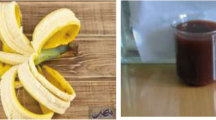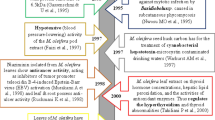Abstract
Supervised field trials at two locations in 2012 and 2013 were conducted to evaluate the dissipation, terminal residues, and safety evaluation of Nativo 75 water dispersible granule (WG) (25 % trifloxystrobin + 50 % tebuconazole) on ginseng and soil following foliar application at a recommended dose 150 (50 + 100) and 1.5 times of the recommended dosage 225 (75 + 150) g a.i. ha−1. The average recoveries of trifloxystrobin and tebuconazole at three spiking levels in ginseng root, stem, and leaf and in soil were in the ranges of 81.0–96.8 % and 80.2–97.5 % with relative standard deviations (RSDs) of 4.92–13.13 % and 4.67–8.35 %, respectively. The half-lives of trifloxystrobin and tebuconazole were 5.92–9.76 days and 4.59–7.53 days, respectively. The terminal residues were all below the maximum residue limits (MRLs) of EU, USA, Canada, Japan, and South Korea. The food safety was evaluated by comparing the estimated daily intake (IEDI) with its acceptable daily intake (ADI). IEDI values calculated from residue data were found to be far less than the ADI on ginseng. Therefore, it would be unlikely to cause health problems induced by Nativo 75 WG use on ginseng at a dosage of 150–225 g a.i. ha−1.



Similar content being viewed by others
References
Attele, A. S., Wu, J. A., & Yuan, C. S. (1999). Ginseng pharmacology: multiple constituents and multiple actions. Biochemical Pharmacology, 58(11), 1685–1693.
Bartlett, D., Clough, J., Godwin, J., Hall, A., Hamer, M., & Parr-Dobrzanski, B. (2002). The strobilurin fungicides. Pest Management Science, 58(7), 649–662.
Bi, X., Xia, X., Mou, T., Jiang, B., Fan, D., Wang, P., Liu, Y., Hou, Y., & Zhao, Y. (2014). Anti-tumor activity of three ginsenoside derivatives in lung cancer is associated with Wnt/β-catenin signaling inhibition. European Journal of Pharmacology, 742(5), 145–152.
Chen, C. Q., Han, S., Gao, J., & Yang, L. N. (2012). First report of ginseng (Panax ginseng) as a natural host of dodder (Cuscuta japonica) in China. Plant Disease, 96(2), 297.
Deng, Z., Hu, J., Qin, D., & Li, H. (2010). Simultaneous analysis of trifloxystrobin, myclobutanil, and tebuconazole residues in apples and soil by SPE clean-up and GC with nitrogen-phosphorus detection. Chromatographia, 71(7-8), 679–684.
European Commission (2013). Pesticide EU-MRLs regulation (EU) No. 212/2013. http://ec.europa.eu/sanco_pesticides/public/index.cfm?event=substance.resultat&s=1.
Jung, C. H., Seog, H. M., Choi, I. W., & Cho, H. Y. (2005). Antioxidant activities of cultivated and wild Korean ginseng leaves. Food Chemistry, 92(3), 535–540.
Jyot, G., Arora, P. K., Sahoo, S. K., Singh, B., & Battu, R. S. (2010). Persistence of trifloxystrobin and tebuconazole on grape leaves, grape berries and soil. Bulletin of Environmental Contamination and Toxicology, 84(3), 305–310.
Kaur, S., Takkar, R., Bhardwaj, U., Kumar, R., Battu, R. S., & Singh, B. (2012). Dissipation kinetics of trifloxystrobin and tebuconazole on wheat leaves and their harvest time residues in wheat grains and soil. Bulletin of Environmental Contamination and Toxicology, 89(3), 606–610.
Lee, H. J., Lee, H. S., Cho, H. J., Kim, S. Y., & Suh, H. J. (2012). Utilization of hydrolytic enzymes for the extraction of ginsenosides from Korean ginseng leaves. Process Biochemistry, 47(3), 538–543.
Lee, K. A., Kim, K. T., Chang, P. S., & Paik, H. D. (2014). In vitro cytotoxic activity of ginseng leaf/stem extracts obtained by subcritical water extraction. Journal of Ginseng Research, 38(4), 289–292.
Liu, X. G., Wang, X., Xu, J., Dong, F. S., Song, W. C., & Zheng, Y. Q. (2011). Determination of tebuconazole, trifloxystrobin and its metabolite in fruit and vegetables by a quick, easy, cheap, effective, rugged and safe (QuEChERS) method using gas chromatography with a nitrogen-phosphorus detector and ion trap mass spectrometry. Biomedical Chromatography, 25(10), 1081–1090.
Mohapatra, S., Ahuja, A. K., Deepa, M., Jagdish, G. K., Parkash, G. S., & Kumar, S. (2010). Behaviour of trifloxystrobin and tebuconazole on grapes under semi-arid tropical climatic conditions. Pest Management Science, 66(8), 910–915.
Montagner, C. C., Vidal, C., Acayaba, R. D., Jardim, W. F., Jardimb, I. C. S. F., & Umbuzeiroa, G. A. (2014). Trace analysis of pesticides and an assessment of their occurrence in surface and drinking waters from the State of São Paulo (Brazil). Analytical Methods, 6, 6668–6677.
Patyal, S. K., Sharma, I. D., Chandel, R. S., & Dubey, J. K. (2013). Dissipation kinetics of trifloxystrobin and tebuconazole on apple (Malus domestica) and soil-A multi location study from north western Himalayan region. Chemosphere, 92(8), 949–954.
Reuveni, M. (2000). Efficacy of trifloxystrobin (Flint), a new strobilurin fungicide, in controlling powdery mildews on apple, mango and nectarine, and rust on prune trees. Crop Protection, 19(5), 335–341.
Sahoo, S. K., Jyot, G., Battu, R. S., & Singh, B. (2012). Dissipation kinetics of trifloxystrobin and tebuconazole on chili and soil. Bulletin of Environmental Contamination and Toxicology, 88(3), 368–371.
Vogler, B. K., Pittler, M. H., & Ernst, E. (1999). The efficacy of ginseng. A systematic review of randomised clinical trials. European Journal of Clinical Pharmacology, 55(8), 567–575.
Wang, T. S. (2001). Chinese ginseng (p. 362). Shenyang: Liaoning Science and Technology Press.
Wang, C. W. (2011). Studies on safety application of fungicides for main diseases of ginseng in Jilin Province (p. 15). Changchun: Jilin agricultural university.
Wang, C. W., Wang, Y., Gao, J., Xu, Y. C., & Cui, L. L. (2014). Dissipation and residues determination of propamocarb in ginseng and soil by high-performance liquid chromatography coupled with tandem mass spectrometry. Environmental Monitoring and Assessment, 186(9), 5327–5336.
Wang, Y., Liu, C., Gao, J., Wang, C. W., Cui, L. L., & Li, A. J. (2015). Dissipation behavior of hexaconazole and kresoxim-methyl residues in ginseng and soil under field conditions. Environmental Monitoring and Assessment. doi:10.1007/s10661-014-4126-6.
Acknowledgments
This work was supported by Agricultural Product Quality and Safety of World Bank Loan Project (No.2011-Z24) and Special Fund for Ginseng Industrial Development of Jilin province in 2011.
Author information
Authors and Affiliations
Corresponding author
Additional information
Yan Wang and Chunwei Wang contributed equally to this work.
Rights and permissions
About this article
Cite this article
Wang, Y., Wang, C., Gao, J. et al. Dissipation, residues, and safety evaluation of trifloxystrobin and tebuconazole on ginseng and soil. Environ Monit Assess 187, 344 (2015). https://doi.org/10.1007/s10661-015-4591-6
Received:
Accepted:
Published:
DOI: https://doi.org/10.1007/s10661-015-4591-6




